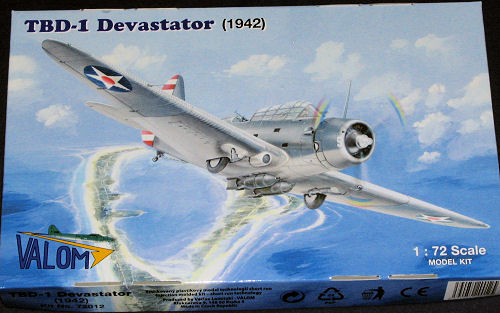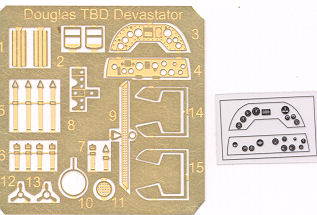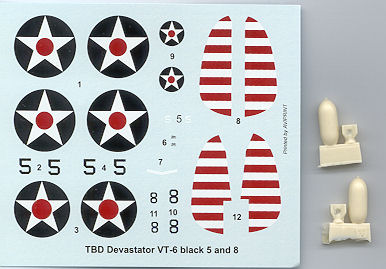
| KIT: | Valom 1/72 TBD-1 Devastator (1942) |
| KIT #: | 72012 |
| PRICE: | $ |
| DECALS: | Two options |
| REVIEWER: | Scott Van Aken |
| NOTES: | Short run with resin and photo etch parts |

| HISTORY |
While the US Navy became
aware by about 1940 that the TBD had become outclassed by the fighters and
bombers of other nations and a replacement (the TBF Avenger) was in the works,
it was not in service yet by the entry of the United States into World War II.
Training attrition had reduced their numbers by then to just over 100 aircraft.
The U.S. Navy assigned popular names to its aircraft in late 1941, and the TBD
became the "Devastator".
In the early days of the Pacific war the TBD acquitted itself well during
February and March 1942 and in the Battle of the Coral Sea, in which Devastators
helped sink the Japanese aircraft carrier Shoho.
Problems were being discovered with the Mark XIII torpedo at this point. Many
were seen to hit the target yet fail to explode; it took over a year for the
problems to be corrected, including a tendency to run deeper than the set depth.
It really wasn't until mid 1944 that the aviators on board carriers were able to
take advantage of these corrections as the submarine and surface forces had
first call on the modified torpedos.
These problems were not corrected by the time of the Battle of Midway on June 4,
1942. Forty-one Devastators were launched from USS Hornet, USS
Enterprise and USS Yorktown to attack the Japanese fleet. Their
fighter escort lost contact, and the TBDs started their attacks without
protection from the Japanese fighters. Torpedo delivery requires a long,
straight-line attack run, making the planes vulnerable anyway, and the slow
speed of the aircraft made them sitting ducks for the Mitsubishi Zeros. One by
one they fell; only four planes made it back to the Enterprise; none to the
Hornet or Yorktown. Worse, not a single torpedo hit its target.
The Navy immediately withdrew the TBD from front-line units after Midway. There
were only 39 aircraft left in any case. They remained in service briefly in the
Atlantic and in training squadrons until 1943. None survived the war.
In fairness to the type, the disaster of the Battle of Midway was as much due to
the vulnerability of torpedo bombers against AAA fire and defending fighters
fielded by an undistracted enemy fleet. Without a fighter escort to keep off the
Zeroes and distract the shipborne AAA guns, not even TBF Avengers escaped nearly
as heavy losses.
| THE KIT |
 Valom
has decided to produce a second TBD kit, but to make this one a bit different
from the original issue. Since this one is basically identical to the first kit
in terms of plastic, I'll just do a repeat . Ignore the torpedo in the picture
to the left. I've shown the bombs in with the decals.
Valom
has decided to produce a second TBD kit, but to make this one a bit different
from the original issue. Since this one is basically identical to the first kit
in terms of plastic, I'll just do a repeat . Ignore the torpedo in the picture
to the left. I've shown the bombs in with the decals.
Valom's kit is very nicely molded with engraved panel lines as one expects from a new mold kit. Gone are the rivets that covered most of the Airfix kit. The corrugations are equally well done. Horizontal stabs are a single piece and look to be well done. I'm sure there will be the usual commentary about the ribbing effect of the flight surfaces, but a light sanding will reduce that if you think it is too much. Since this is short run, low pressure molding, the level of detail isn't as crisp as you'd find on high pressure kits from Revell or Tamiya, but it is quite good. The sprue runs into the parts will often go into the join areas so clean-up will be a bit more than the norm. The large parts have small ejector towers that will need to be removed prior to construction.
I found the plastic to be well done and my single concern is with the prop. One of the blades has a large sink area on it and the hub isn't really that well detailed. I'm not sure if Aeroclub has a replacement but it may be something to consider. You need a 10' 3" Hamilton Standard. The canopy is well molded with strong frame lines so masking should be easy. It is a bit on the thick side so seeing any detail in the cockpit area would be somewhat problematical. The cockpit is a single piece reaching from front to back so in order to show anything open, either you'll have to cut the canopy or look for a vacuform replacement.
 Most of the detail parts are in resin, and this
includes the complete interior, wheels, and cowling. The bombs, parts that are
peculiar to this boxing, are nicely done in resin. One simply puts on the lower
fuselage blanking plate and the two strip pylons that were not used on the
earlier kit, to mount the bombs.
The resin bits are, for the most part, well molded. I had a few fragile bits
broken while jostling around in the bag and I found several air pockets in the
cowling that will have to be filled, but overall it is well done.
Most of the detail parts are in resin, and this
includes the complete interior, wheels, and cowling. The bombs, parts that are
peculiar to this boxing, are nicely done in resin. One simply puts on the lower
fuselage blanking plate and the two strip pylons that were not used on the
earlier kit, to mount the bombs.
The resin bits are, for the most part, well molded. I had a few fragile bits
broken while jostling around in the bag and I found several air pockets in the
cowling that will have to be filled, but overall it is well done.
The cockpit/crew compartment is a single casting with the seats and consoles cast into it already. Basically, one just adds the etched belts and a few resin bits (like the aft gunner's position) to be ready to go. The kit's resin engine is well molded ad appears to be somewhat generic, but should be most convincing when painted and detailed. Instrument panels are etched brass with acetate instrument backings, something that always works out well. The rest of the build is pretty basic short run stuff with no alignment pins and butt joins the norm.
Valom's instructions have gone to that next step from
their previous offerings. They are well printed on gloss paper with the cover
and painting/markings guide in full color. The back page is specifically for a
color chart that offers Humbrol, Agama, Model Master, Gunze, and FS 595
references. The construction steps are well drawn and, thankfully, the painting
and part number blocks are much smaller so don't overwhelm the diagrams. A very
nice addition is a well drawn thre e
view. Markings are provided for two aircraft. Both are later war aircraft in the
Blue-Grey upper and Light Grey lower surfaces. Much easier to paint than the
earlier kit. One is for the Wake Island raid of February 1942. This one has a
very large fuselage insignia. The other is for the USS Enterprise aircraft from
April of 1942 when it partook in attacks on various Japanese island
installations. This one has the smaller fuselage insignia. There are rudder
stripes for both, which I find a tad odd as one will only be building one of the
options in the kit! Again, the decals are done by Aviaprint and nice and crisply
printed, though I'll have to confess that the red is a bit out of register on
the large insignia and really out of register on the smaller ones.
e
view. Markings are provided for two aircraft. Both are later war aircraft in the
Blue-Grey upper and Light Grey lower surfaces. Much easier to paint than the
earlier kit. One is for the Wake Island raid of February 1942. This one has a
very large fuselage insignia. The other is for the USS Enterprise aircraft from
April of 1942 when it partook in attacks on various Japanese island
installations. This one has the smaller fuselage insignia. There are rudder
stripes for both, which I find a tad odd as one will only be building one of the
options in the kit! Again, the decals are done by Aviaprint and nice and crisply
printed, though I'll have to confess that the red is a bit out of register on
the large insignia and really out of register on the smaller ones.
Judging by Valom's future release sheet, there isn't a boxing for a wartime torpedo plane. This shouldn't be a problem if you have the earlier kit as you can do a swap which will allow you to do a Coral Sea or Midway plane with a torpedo and a prewar plane with no ordnance (which is how they were flown the vast majority of the time).
| CONCLUSIONS |
Once again, I have to say that this is a winner. I've heard so many comment that we needed a new mold Devastator and now you have not one but two of them. They should be a relatively normal build for those of us who are used to short run kits and would be a good introduction to those who haven't given one a go.
January 2006
| REFERENCES |
The internet
Thanks to Valom for the review kit.
If you would like your product reviewed fairly and quickly by a site that has over 300,000 visitors a month, please contact me or see other details in the Note to Contributors.